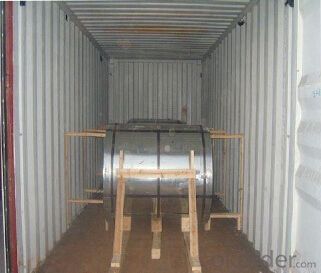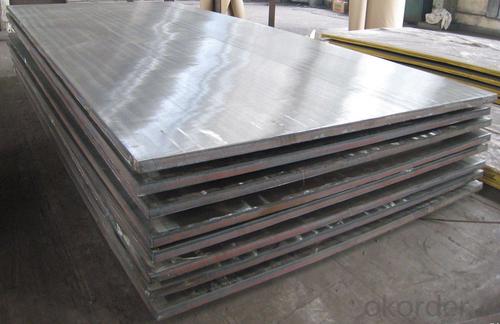Stainless Steel plate 304 with No.4 Surface Treatment
- Loading Port:
- Shanghai
- Payment Terms:
- TT OR LC
- Min Order Qty:
- 500 m.t.
- Supply Capability:
- 5000000 m.t./month
OKorder Service Pledge
OKorder Financial Service
You Might Also Like
Hot sale stainless steel sheet 201/202/304/304l/310S/309S/316L/316Ti/316/321,410/420/430/444/443/409L, and 904L.
Description of Stainless Steel Sheet:
Description | steel sheet,hot rolled steel sheet,cold rolled steel sheet, steel sheet,sheet,steel plate |
Standard | ASME, ASTM, EN ,BS,GB,DIN, JIS etc |
Application | Steel sheet applies to construction field, ships building industry, petroleum & chemical industries, war and electricity industries, food processing and medical industry, boiler heat exchanger, machinery and hardware fields. |
Packaging | Standard export sea-worthy packing |
Delivery time | 10-30 days |
Quality | No.1 |
Productivity | 500 tons/Day |
Note | Our company has cooperative relation between the domestic agents. Stainless steel sheet can be made accordingto the customers requirements. Fasten delivery. Quality assured. |
Contacts | If you have any question,please feel free contact me. |
Stainless steel sheet surface finish characteristics
Surface finish | Characteristics and application |
2B | The surface brightness and flatness of no2B is better than no2D. then through a special surface treatment to improve its mechanical properties,No2B could nearly satisfy comprehensive uses. |
No.1 | Polished with abrasive belt of grit#100-#200, have better brightness with discontinuous coarse stria, used as inner and external ornaments for building, electrical appliances and kitchen utensils etc. |
No.4 | Polished with abrasive belt of grit #150-#180,have better brightness with discontinuous coarse stria, but thinner than No3, are used as bathtub buildings inner and external ornaments electrical appliances kitchen utensils and food processing equipment etc. |
HL | Polished with abrasive belt of grit #150-#320 on the NO.4 finish and has continuous streaks, mainly used as buildings ornaments elevators, door of building, frontal plate etc. |
BA | Cold rolled, bright annealed and skin-passed, the product have excellent brightness and good reflexivity like mirror, kitchen apparatus, ornament etc. |
8K | The product have excellent brightness and prefer reflexivity can to be the mirror. |
Main Features of stainless steel sheet :
•Escalator, Elevator, Doors
•Furniture
•Production tools, Kitchen appliances, freezers, cold rooms
•Auto Parts
•Machinery and Packaging
•Equipment and Medical devices
•Transport system
Product Details:



Sandard Seaworth Packing(wooden packing with water proof paper)


FAQ:
1. What's the quality?
very fine
2. How long get reply?
within 24 hours
If you have any question about stainless steel sheets,donot forget to sending the email to Us! You will get the competitive Price and have a very good experience about the Buying Process! CNBM International Corporation is always your trustful friend!
- Q: What are the benefits of using textured stainless steel sheets in decorative lighting fixtures?
- Using textured stainless steel sheets in decorative lighting fixtures offers several benefits. Firstly, the textured surface adds visual interest and enhances the overall aesthetic appeal of the fixture. The texture can create unique patterns and reflections, adding depth and dimension to the lighting design. Additionally, stainless steel is a durable material that is resistant to corrosion and staining, ensuring the longevity and durability of the fixture. This makes it a reliable choice for decorative lighting fixtures that are exposed to different environmental conditions. Moreover, stainless steel is easy to clean and maintain, requiring minimal effort for upkeep. Overall, the use of textured stainless steel sheets in decorative lighting fixtures combines both functional and aesthetic advantages, making it an ideal choice for designers and homeowners alike.
- Q: What's the difference between cold rolled plate and stainless steel?
- Cold rolled steel plates will soon rust (in the wind and rain). Rust must be painted outsideAs the price of chromium and nickel is very high, the price of stainless steel plate is several times that of ordinary cold-rolled steel sheet
- Q: Can stainless steel sheets be used for electromagnetic shielding?
- Yes, stainless steel sheets can be used for electromagnetic shielding. Due to its high electrical conductivity and magnetic permeability, stainless steel can effectively block electromagnetic radiation and protect sensitive electronic devices from interference.
- Q: Are stainless steel sheets suitable for medical implants?
- Yes, stainless steel sheets are suitable for medical implants. Stainless steel is commonly used in medical implants due to its excellent corrosion resistance, mechanical strength, and biocompatibility. It can be easily sterilized, is durable, and has a long track record of successful use in various medical applications.
- Q: What industries commonly use stainless steel sheets?
- Stainless steel sheets are extensively used in various industries due to their exceptional properties and versatility. One industry that commonly utilizes stainless steel sheets is the construction industry. Stainless steel sheets are used for roofing, cladding, and decorative purposes, providing durability, corrosion resistance, and an aesthetically pleasing appearance. Another industry that extensively uses stainless steel sheets is the automotive industry. Stainless steel sheets are used for manufacturing body panels, exhaust systems, and various components due to their high strength, heat resistance, and corrosion resistance properties. Additionally, stainless steel sheets are also used in the production of fuel tanks and other critical components in the transportation sector. The food and beverage industry also heavily relies on stainless steel sheets. These sheets are used for fabricating food processing equipment, storage tanks, and pipelines. Stainless steel sheets are preferred in this industry due to their resistance to corrosion, high cleanliness standards, and the ability to withstand extreme temperatures, ensuring hygienic and safe food processing. The medical and pharmaceutical industries also extensively use stainless steel sheets. These sheets are used for manufacturing surgical instruments, medical devices, and equipment due to their corrosion resistance, biocompatibility, and ease of sterilization. Moreover, the energy sector, including oil and gas, power generation, and renewable energy industries, commonly uses stainless steel sheets. These sheets are utilized for constructing pipelines, storage tanks, and various equipment in these industries due to their resistance to corrosion, high temperature, and pressure. Other industries that commonly use stainless steel sheets include aerospace, marine, chemical processing, and architectural industries. Stainless steel sheets provide the required strength, durability, and resistance to harsh environments in these sectors. Overall, stainless steel sheets find applications in a wide range of industries due to their exceptional properties, making them a preferred choice for various manufacturing and construction needs.
- Q: How do I remove stains or marks from stainless steel sheets?
- To remove stains or marks from stainless steel sheets, you can follow these simple steps: 1. Start by cleaning the stainless steel surface with a mild detergent or dish soap and warm water. Gently scrub the affected area using a soft cloth or sponge. Rinse thoroughly with clean water and dry with a clean towel. 2. If the stain persists, you can try using white vinegar. Dampen a cloth or sponge with vinegar and gently rub the stained area. Vinegar's acidic properties can help break down the stains. Rinse the surface with water and dry it thoroughly. 3. For tougher stains or marks, you can create a paste using baking soda and water. Apply the paste to the affected area and gently rub it in using a soft cloth or sponge. Let it sit for a few minutes, then rinse with water and dry thoroughly. 4. If the above methods do not work, you can try using a stainless steel cleaner specifically designed for removing stains or marks. Follow the instructions on the cleaner's packaging for best results. Remember to rinse the surface thoroughly and dry it completely after using a commercial cleaner. 5. It is important to avoid using abrasive cleaners, steel wool, or harsh chemicals on stainless steel sheets as they can scratch or damage the surface. Also, always test any cleaning method or product on a small, inconspicuous area before applying it to the entire surface. By following these steps and using the appropriate cleaning methods, you should be able to effectively remove stains or marks from stainless steel sheets and restore their original shine and appearance.
- Q: What glue does the board and the stainless steel stick to?
- Board and stainless steel fast drying, you can choose one adhesive HY-303 glue to bonding, quick curing, simple and convenient operation. Slow dry, you can choose HY-106AB glue to bonding, high temperature resistance, good weather resistance.
- Q: Can stainless steel sheets be used for electromagnetic compatibility?
- Yes, stainless steel sheets can be used for electromagnetic compatibility. Stainless steel is a highly conductive material that can effectively shield against electromagnetic interference (EMI) and radio frequency interference (RFI). It can be used to create enclosures or shielding to protect sensitive electronic devices from external electromagnetic fields.
- Q: What is stainless steel AB board, please?
- Both 2B and BA can be polished into 8K mirror panels, but 2B requires more polishing steps, and the BA can only be polished to achieve the 8K effect. Depending on the end product, there is a difference in whether the BA is polished and some BA products do not need to be polished and used directly.
- Q: Can stainless steel sheets be used for medical instruments?
- Yes, stainless steel sheets can be used for medical instruments. Stainless steel is a popular choice for medical instruments due to its excellent corrosion resistance, durability, and ease of sterilization. It is non-reactive, which means it does not leach any harmful substances into the body during medical procedures. Stainless steel sheets are used to manufacture various medical instruments such as surgical tools, implants, dental instruments, and diagnostic equipment. The smooth surface of stainless steel sheets also makes them easy to clean and maintain, which is crucial for maintaining sterility in medical settings. Overall, stainless steel sheets are a reliable and widely used material for manufacturing medical instruments.
Send your message to us
Stainless Steel plate 304 with No.4 Surface Treatment
- Loading Port:
- Shanghai
- Payment Terms:
- TT OR LC
- Min Order Qty:
- 500 m.t.
- Supply Capability:
- 5000000 m.t./month
OKorder Service Pledge
OKorder Financial Service
Similar products
Hot products
Hot Searches
Related keywords






























